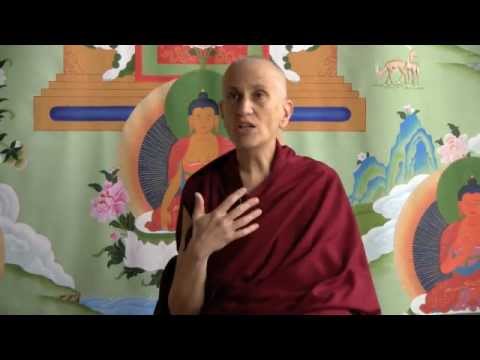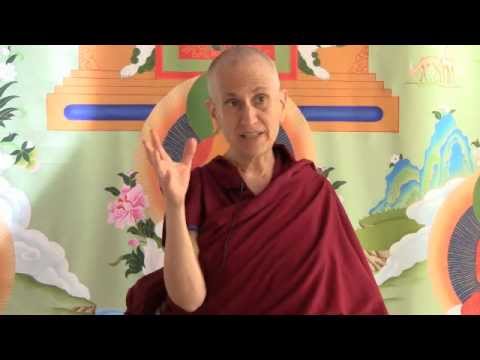The dangers of absolutism and nihilism
A Crown Ornament for the Wise, a hymn to Tara composed by the First Dalai Lama, requests protection from the eight dangers. These talks were given after the White Tara Winter Retreat at Sravasti Abbey in 2011.
- “Wrong” views are views that won’t lead to liberation
- Nihilism is especially dangerous since it denies the existence of karma
The Eight Dangers 10: The thieves of wrong views, part 2 (download)
I think we were in the middle of the “thieves of wrong views.”
Roaming the fearful wilds of inferior practice,
And the barren wastes of absolutism and nihilism,
They sack the towns and hermitages of benefit and bliss:
The thieves of wrong views—please protect us from this danger!
“Roaming the fearful wilds of inferior practice.” What is inferior practice? It means—here—practicing some spiritual path with distorted views, or wrong views. That’s called an inferior practice because it’s not going to get you to liberation or enlightenment. Okay? So, examples of it— “And the barren wastes of absolutism and nihilism.” Okay?
Absolutism and nihilism are examples of wrong views that one would adhere to if one followed an inferior practice. So, for example, being nihilistic would be like saying, “There’s no such thing as mind. The mind is just a property of the brain. Everything we are is due to our genes, due to our chemical functioning in our brain. So we have no personal responsibility for anything we do.” That would be a wrong view.
Or another nihilistic view would be, “Nothing exists…” Mistaking emptiness of inherent existence for total nonexistence. Mistaking things to be LIKE a dream to BEING A dream. Yes? And so saying, “Nothing exists. There’s no good. There’s no bad.” You know? All these kinds of things, some kind of nihilistic view.
A nihilistic view regarding ultimate truth would lead you to a nihilistic view in terms of cause and effect. So, “Oh, it doesn’t matter what you do, because…” Yes?
Or another nihilistic view would be saying there’s no such thing as rebirth. That when we die we’re dead, the mind discontinues, the person discontinues. There’s nothing.
So that would be on the nihilistic side.
The absolutist side is saying things are inherently existent. So there’s like a real, permanent soul, something that you really are. There’s an inherently existent creator who creates the universe, who you have to please or do whatever to. So some kind of inherently existent creation. Or soul inside of us that is truly existent.
Both of those—whether we’re absolutist or nihilist—we’ve missed the middle way view. And so we’re not going to get to liberation and enlightenment because we’re not going to understand the union of emptiness and dependent arising properly. So we’re not going to be able to eliminate the ignorance which is the root of samsara.
Of these two things—the absolutist and the nihilist—the nihilist is said to be worse because if you have a nihilist view regarding ultimate truth then you’re going to deny the law of cause and effect and say karma doesn’t exist, rebirth doesn’t exist. Whereas if you have an absolutist view, you might still believe in karma and rebirth, and just see them all as truly existent. But still you’re going to have some energy to keep good ethical conduct because you believe that there’s a next life and what your actions do will influence it. Okay? So in that way you can see that people from other religions still could create good karma because they may have an absolutist viewpoint, but they have respect for the fact that their actions have some ethical implications. Whereas somebody who says, “There’s no consciousness whatsoever,” or, “there’s nothing after death,” or, “There’s no good, no bad…” Then they don’t have any kind of restraint in terms of their ethical conduct.
We’ll talk some more about wrong views. I think it’s an important one.
Venerable Thubten Chodron
Venerable Chodron emphasizes the practical application of Buddha’s teachings in our daily lives and is especially skilled at explaining them in ways easily understood and practiced by Westerners. She is well known for her warm, humorous, and lucid teachings. She was ordained as a Buddhist nun in 1977 by Kyabje Ling Rinpoche in Dharamsala, India, and in 1986 she received bhikshuni (full) ordination in Taiwan. Read her full bio.


